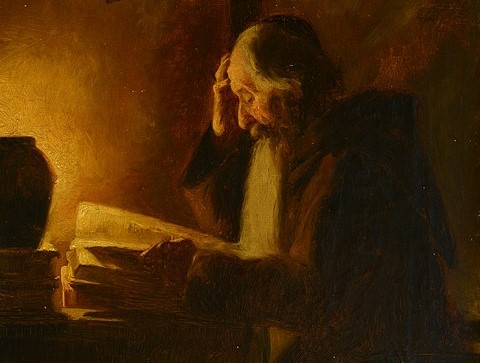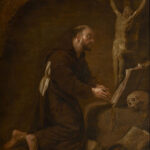That’s how I opened my first piece in this series on the relationship between craft and theological education, and I still think I’m right. In it we observed St. Francis of Assisi through the lens of Hugh of St. Victor (and Ivan Illich with the assist) to explore what work in the material world has to do with our thoughts about God and why it is a most fitting union. In this piece, I turn from the abstract idea of the marriage between the outer world of work and the inner world of the spirit to centers of education that are midwifing this renaissance of theologically-informed labor. In a final piece I will dare to speculate on a question I feel ill-equipped to answer: why is this happening now?
The Schools
I may not have dozens of schools to list. In fact, I don’t know that I have even one dozen. But there are more than zero so that must count for something, and as classical, holistic forms of education grow in popularity this list is sure to lengthen. Below are a few of the schools and what they’re up to. After, I’ll make some observations on emphases that both set the schools apart from one another and unite them in a common goal.
Saint Andrew’s Academy
Seated in the south of Boone County in northeastern Kentucky, Saint Andrew’s Academy is a Roman Catholic boarding school for ninth- to twelfth-grade boys that welcomed their first group of freshmen in September, 2023.
The dozen boys selected to be part of the inaugural class will fill their minds with History, Latin, Literature, Religion, Mathematics; they will memorize folk songs and learn Gregorian chant; they will take up the hammer for Woodworking and Blacksmithing and learn to tend plants and animals in Farming; and they will worship and pray together in the Mass and the Daily Offices. While the rest of the schools in the list are at the undergraduate or higher levels, Saint Andrew’s is unique in its formation of 13-18-year-old men.
“These first 12 students must be up for an adventure,” the website says, “and be ready to give themselves generously to a way of life that will challenge them spiritually, intellectually and physically. They must welcome the opportunity for some time away from technology in order to experience the deeper joy that comes from fulfilling man’s natural desire to reflect, wonder, think, converse and develop friendship–all things that take time and attention, but things that bear much fruit.”
Greystone Theological Institute
Lest the Romans have all the fun, Greystone Theological Institute presents us with a strong Reformed option in Coraopolis, Pennsylvania. GTI isn’t officially connected to a particular denomination, but its faculty hail from Presbyterian, Continental Reformed, Anglican, and Reformed Baptist backgrounds, and they are all dedicated to Reformed Catholicity.
Among their more traditional theological offerings one will find, sticking out like the sore thumb students will certainly have at least once during their course of study, the Mechanical Arts Program (MAP). The website describes their influences thusly:
“The Greystone network of craftspeople (spread throughout the USA and world) includes masters in woodworking, plumbing, farming, gardening, viticulture/wine, medicine, permaculture, automotive mechanics, textiles, culinary arts, teaching, finance, law, and more. Alongside Hugh of St. Victor, other philosophical or theological influences for the MAP include professor of furniture design David Pye, writer and motorcycle mechanic Matthew Crawford, philosopher Roger Scruton, anthropologist Tim Ingold, writer and farmer Wendell Berry, theologian and social critic Ivan Illich, priest and chef Robert Farrar Capon, philosopher of technology Albert Borgmann, and others.”
Joshua Klein–author, woodworker, and founder of Mortise & Tenon Magazine–is helping to direct this program as Greystone’s Associate Fellow in Mechanical Arts. He has a series of five conversations (first one here) with Dr. Mark A. Garcia and the inimitable Mr. Michael Sacasas unpacking the vision for the school, what they hope to accomplish, its theological and philosophical underpinnings, and the resurgence of craftsmanship and the trades in our time. Whether or not you have interest in attending the school, I highly recommend listening to these conversations. Preferably more than once.
The Maker Institute of Studio Art + Theology
Another entry from the Protestants, this one based in Richmond, Virginia, The Maker Institute employs a hybrid model of learning that is focused on reading, writing, and week-long intensives on campus. While they don’t have any official denominational affiliation, they do pull from the wider catholic Christian tradition, citing the Apostles’, Nicene, and Chalcedonian Creeds as well as the Belgic and Helvetic Confessions, the Thirty-Nine Articles of Religion, and others as representing their doctrinal convictions.
I don’t think many will argue when I say that the state of the arts in the modern West is in total shambles, a far cry from the God-empowered and -directed work of Bezalel and Oholiab in Exodus 31–the first people in Scripture said to be filled with God’s Spirit, and tradespeople and artists to boot. The Maker Institute is focused, as their name implies, on making Spirit-filled Bezalels out of “makers”: those who “have an interest in painting, drawing, graphic design, photography, illustration, collage and mixed media, sculpture, installation, 3-D design, theater, church media, curation, new media, film, or more.” TMI is unique among the schools listed here for veering from construction or manufacturing trades in favor of skills and disciplines at which those with more practical sensibilities might look askance. But such condescension is misplaced: if it is true that politics is downstream from culture, as Andrew Breitbart famously said, then it seems that art, too, lies somewhere upstream of politics.
There are three levels of study and thirteen programs, combining twenty-seven courses, for prospective students to choose from. At the core of it all is a dedication to the Holy Bible and a well-developed theology of art. Students are encouraged, with the exception of being on campus for one week per semester, to maintain their lives at home, integrating their family, friends, work, and worship into a cohesive whole so they can best serve the Church and their community as cultivators of truth, beauty, and goodness.
College of St. Joseph the Worker
Announced in the middle of 2022, the College of St. Joseph the Worker puts forth another strong option for those wanting to integrate their interior lives and the work of their hands according to the Roman Catholic tradition. Those familiar with Steubenville, Ohio will be completely unsurprised to discover that this is where you’ll have to go to find this school.
St. Joseph’s offers a six-year program focused on developing the lay vocation of family, work, and one’s place in the polis. The first three years include exposure to both the trades and the Catholic intellectual tradition, but heavily front-loads theology since the latter three years will be spent apprenticing. Students will be expected to live in Steubenville so they can engage not only in what may be one’s first exposure to the trades, but also in lectio (lectures, reading) and disputatio (seminar-style dialogue between conflicting ideas). These two are not ends unto themselves: St. Joseph’s is ordered toward deeply internalizing what is learned through meditatio (meditation) and praedicatio (preaching). One cannot give what one hasn’t got, so by making theology a part of their interior lives through prayer, they will then give the Gospel to those around them by preaching: not the preaching of a homily in the liturgy, but by arranging the temporal order so that the polis is an instantiation of God’s kingdom. Once their three years on campus in Steubenville comes to a close, students will then continue theological formation via web-based learning while focusing on one trade of their choice–HVAC, plumbing, electrical, or carpentry. Their apprenticeships will be overseen by qualified masters of their respective trades in a network of craftsmen around the United States.
As with the other schools, there is a cost to attend. In this case the cost does not include books, utilities, or food, but does include boarding (the website adds “for most students”): $15,000 USD per year for the first three years, and that drops to $5,000 USD per year for the latter three. Unlike other schools, that cost can be partially or entirely offset by the money earned in the apprenticeship, landing graduating students in a net neutral or net positive financial situation. If there is a traditional college program that can make this claim, I don’t know of it.
Harmel Academy
The last on this list, Harmel Academy, is located in Grand Rapids, Michigan, smack-dab in the thick of America’s Industrial Heartland, which we now call “the Rust Belt.” Harmel’s founders built the school on the four pillars of prayer, work, study, and community. Officially Roman Catholic, Harmel accepts the applications of men from other traditions while also requiring that they participate in the daily Liturgy of the Hours and imbibe the thoughts and teachings of, among others, Catholic luminaries.
Like The Maker’s Institute, Harmel narrows its focus in terms of scope–if you attend here, your only trade option is to study manufacturing; unlike The Maker’s Institute, students are required to go all in and move to the campus for the duration of their studies. Why this discreet focus and emphasis on in-person study? Because the school is situated in what remains a major manufacturing corridor. Job opportunities are plentiful and the plants need the Gospel. Harmel wants to form Christian men who view their work through the lens of prayer and view prayer as their life’s work.
Harmel’s two-year Machine & Systems Technology Program, their primary program, “prepares men for employment in multiple high demand occupations either as skilled machinists, millwrights, or manufacturing service technicians.” They will study Fluid Power, Electrohydraulics, and Pneumatics; Robotics; Welding and Fabrication; Computer Aided Design and Machining (CAD/CAM); and more. Notably, the school’s welding instructor is also a Roman Catholic priest and serves as Harmel’s chaplain, which I think is just swell. They also have a popular “gap year” program that will offer instruction in a slightly broader swathe of trade skills, and deeply integrated in both the main and gap year programming is a rich study of the Humanities, a four-semester cycle named God and Man at Work. MST students will take all four semesters while gap year students take only two.
Other Institutions
Even outside explicitly religious institutions there is a recognition of the need for the integration of manual and mental labor. The American College of the Building Arts in Charleston, South Carolina, awarded its first degrees in 2009. Students go through a program that combines the American liberal arts degree model with European-style artisan training in trades like blacksmithing, timber framing, plaster, architectural carpentry, and more.
Elsewhere one might find the Work Colleges Consortium. These work colleges – schools that integrate work, learning, and service into a comprehensive whole according to the Consortium’s standards and recognized by the U.S. Department of Education – range in size, location, and emphasis, but they all offer liberal arts degrees, work experience, and reduced educational cost compared to traditional four-year universities.
Some Observations
The first thing worth saying is that I’ve done none of these programs anything close to justice. There are entire teams of souls, entire traditions, and probably centuries’ worth of combined thought behind each school, a breadth and depth I find myself struggling to represent well. Do yourself (and them) a favor and browse through their websites to see the vision of each institution. These programs are pulling from rich philosophical thought on work both within and out of the Church and from the theological depths of Christian tradition, East and West. Many of the same names are present across the schools’ sites–Crawford, Weil, Berry, Tolkien, Hugh of St Victor–and yet, for all their similarities, it’s worth pointing out how they differ. I don’t mean denominationally, but in which skilled manual activities they employ and the intention for employing them at all.
Some, like Saint Andrew’s and Greystone, include what I would consider legacy or artisanal trades: those which have been foundational to pre-industrial societies but, while they may have important personal utility, aren’t widely useful in terms of our modern economy. In these cases, the value of teaching these skills beyond simply keeping them alive (or to open an Esty shop) is the development of moral and intellectual faculties implicit in manual work and, particularly in Saint Andrew’s, cultivating the fruit of the Spirit in the context of shared life with other young men. If society continues down the path its on, these “legacy trades” may yet become the most relevant of all.
But their efforts can’t be reduced to an Aristotelian effort to perform physical work as a means to greater leisure and philosophical contemplation. That would be an extremely unfair reduction of their project. Bridging the gap from historical to hirable, Greystone offers training in immediately employable skills, and it’s worth noting that all seminarians will be required to go through their Mechanical Arts Program. “All?” All. Going back to my previous essay, remember St. Francis? For him, to repair Christ’s church was precisely to repair church buildings. Pastoral ministry may have more to do than being about the business of existing in and ordering the material world, but it certainly cannot have less. A literal grip on things can help as young pastors seek to build God’s kingdom here, “on earth as it is in heaven.”
Other schools, like Harmel Academy and the College of St. Joseph the Worker, are training folks exclusively in the construction and manufacturing trades. They are looking to supply communities and the businesses that serve them with tradespeople that are whole humans, complete with a developed sense of vocation as God’s sub-creators, and immediately employable. There are few greater joys than the realization that the person tinkering on your water pipes or car engine is not merely good at their work and in possession of a bland, HR-enforced politeness, but is, in fact, a saint.
Still another, the Maker’s Institute of Studio Art + Theology, while sharing in the theological and philosophical underpinnings of the other schools, differs in applying them to the realm of the arts. These artist-theologians may not be knocking on neighborhood doors to service toilets or change air filters, and they may not be working the floor of a manufacturing plant, but they are using their bodies and souls to create those images and symbols that serve our imaginations and shape our sense of beauty, thereby drawing us deeper into the mystery of God. Art shapes and is shaped by culture; we, therefore, require holy art produced by holy artists to inspire holy imaginations that architect a holy society that forms holy people.
It seems to me that all of the schools, regardless of particular emphasis, are aiming in the same direction: at the integration of entire humans–mind, character, spirit, and body. If we’re interpreting it charitably, education in the form we’ve come to know it in the modern West is focused almost entirely on the development of the mind. What we know of as “physical education” feels like a modular attachment rather than an integrated part of the whole, existing primarily as a way of preventing obesity and fostering milquetoast sociability and corporation-approved teamwork, not to teach skills much less form embodied souls. But with the schools listed above, taking up a hammer, let’s say, is an embodied act that demands the recruitment of the interior life such that what its face is applied to is ordered rightly: both to spec, making it technically good, and to Jesus, making it liturgically oriented. Tech support and Our Lord ought to be pleased with our good work.
“Now of all creatures the rational creature is chiefly ordained for the good of the universe,” said St. Thomas Aquinas in his discussion of predestination in his famous Summa Theologica. He had soteriology in view, but I find this to be a succinct statement of what I think I and these schools are getting at: the dignity of manual labor is found in our ordering the material world around us such that it in turn orders the humans situated in it toward the good which, as we said last time, is ultimately found in the Word of God become Flesh. A mutual ordering which takes all of creation up into the life of God. Perhaps this is making a soteriological statement after all.
One final observation that will carry us into the third essay is this: all these schools have either started within the last few years or will be starting in the year ahead. Why is this? What precipitated this resurgence? A resurgence not only in an interesting idea, but in these particular schools with the particular focus of enacting this idea? It’s a question that feels an awful lot like trying to grasp after the wind which “blows where it wishes,” so the best I can hope to do is describe the sound it makes as it fills our sails and carries us forward.
Image credit: Wikimedia Commons






5 comments
Ed Hagenstein
This is so great to know about—thanks to FPR and to the author.
Ruth Gaskovski
Nate – what an absolutely splendid series. So happy that your unique work is here on the FPR! I had never come across these schools yet and will save them for future reference.
CCM
In this context of learning trades, as a Christian academic endeavor, consider the Bruderhof Mount Academy (https://www.mountacademy.org/).
Fr. Mark Perkins
I’m loving this series!
St. Dunstan’s Academy in Roseland, Virginia intends to be part of this list, as our first five-minute video suggests: https://www.youtube.com/watch?v=FeTRcPUQfWw
Fr. Mark Perkins
Chaplain and Assistant Headmaster
St. Dunstan’s Academy
Haley
This is an incredible endeavor – much good in the lives of boys and men will come from this.
Comments are closed.